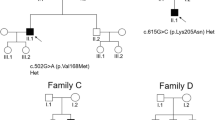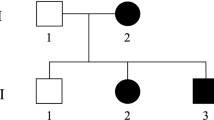Abstract
We studied nine Italian families with a pure form of autosomal dominant spastic paraplegia (ADHSP) to assess the frequency of mutations in the SPG4 gene. We observed marked intrafamilial variability in both age-at-onset and clinical severity, ranging from severe congenital presentation to mild involvement after age 55 years to healthy carriers of the mutation after age 70. Four of nine probands harboured SPG4 mutations, We identified three new SPG4 mutations, all predicting a loss-of-function with apparently important consequences for spastin function. RT-PCR studies predict loss-of-function as a possible mechanism leading to spastin-related HSP. The current study expands the spectrum of allelic variants in SPG4, confirming their pathological significance in pure AD-HSP and suggesting implications for the presumed function of spastin.
Similar content being viewed by others

Author information
Authors and Affiliations
Additional information
Received: 15 December 2000, Received in revised form: 29 May 2001, Accepted: 18 June 2001
Rights and permissions
About this article
Cite this article
Patrono, C., Casali, C., Tessa, A. et al. Missense and splice site mutations in SPG4 suggest loss-of-function in dominant spastic paraplegia. J Neurol 249, 200–205 (2002). https://doi.org/10.1007/PL00007865
Issue Date:
DOI: https://doi.org/10.1007/PL00007865



